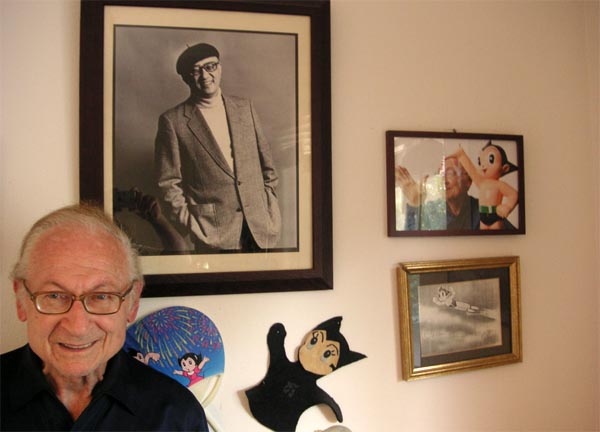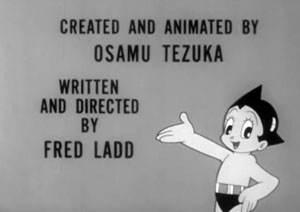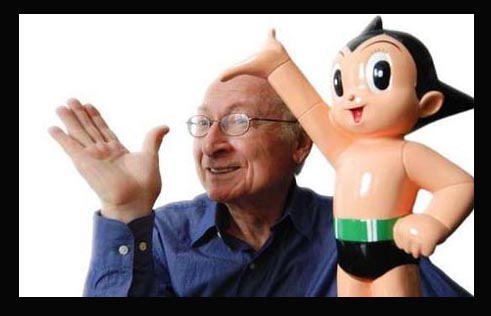And who can forget MUTT AND JEFF MEET BUGOFF? Fred also produced and packaged for the U.S. the Russian SPACE EXPLORERS, the educational The Big World Of Little Adam, and partnered in cartoon businesses with Elliot Hyman (A.A.P. Productions) and Graham Place (veteran Fleischer animator) for various projects.
He was an amazing, energetic cheerleader for all animation in his later years… and I’ll miss his phone calls and appearances at Asifa screenings. I asked Ladd’s biographer and friend Harvey Deneroff to write a remembrance, below. Fan of his work or not, its undeniable Fred played an important part in bringing Japanese animation to North America. I dare say the deluge of anime today began with Fred Ladd’s efforts to make it appealing to western audiences – and the art form has thrived due to his championship. – Jerry Beck

I first got to know Fred Ladd when I started putting together the August 1996 issue of Animation World Magazine (AWN.com), which focused for the first time on anime. Fred Patten suggested I interview him as an important figure in the anime world. I really did not much about the topic at the time, but I knew enough to know Japanese animation was a force to be reckoned with. (This was prior to the Pokémon TV series which really opened up the floodgates, once and for all, to anime in the United States.) The response to my interview though surprised me. It not only became one of the most popular pieces I ever published, but it forever linked me to Ladd and somehow made me an instant anime expert.
 The story of how Fred Laderman (aka Ladd) was hired by NBC Enterprises in 1963 to prepare a pilot episode for American audiences of Osamu Tezuka’s Tetsuwan Atomu (Mighty Atom), that resulted in the “creation” of Astro Boy, is well known.
The story of how Fred Laderman (aka Ladd) was hired by NBC Enterprises in 1963 to prepare a pilot episode for American audiences of Osamu Tezuka’s Tetsuwan Atomu (Mighty Atom), that resulted in the “creation” of Astro Boy, is well known.
At the time, Ladd was something of a hustler who had become known for his adaptations of European animated films that were edited and dubbed into English and sold into syndication to individual (usually non-network) TV stations around the country. This was the same market that Astro Boy was sold to with great success, at times even beating out shows like The Mickey Mouse Club in ratings. But to Ladd, Astro Boy was just another job and not the breakthrough for anime in the international market it came to be.
With Tetsuwan Atomu, Tezuka had sought to capitalize on the legendary success of his manga by adapting one of them for his first animated TV show. He was obviously thinking of the overseas as well as the Japanese market when it went into production. As Frederik L. Schodt has pointed out, he avoided references to Asian religions in favor of Christianity, and even included some signage in English. Ladd realized that Tezuka’s attempts to appeal to a Western audience would not pass muster with NBC’s Standards and Practices (i.e., censors). As such, Ladd felt obliged to eliminate scenes of violence and nudity, and what he considered offensive religious references.
In terms of the soundtrack, he tried to enliven what he saw as dead spots with everyday sound effects, such as traffic noise. In addition, he added lyrics to Tatsun Takai’s iconic opening theme music, an idea which Tezuka promptly copied for future episodes.
Tezuka and his crew at Mushi Production were basically coached by Ladd on the needs of the lucrative American market. And soon other TV animation studios sprung up in Japan to capitalize on the Astro Boy’s success. So, it is not without reason that Tezuka, the God of Manga, dubbed Ladd “the Godfather of Astro Boy”!
Before he began work on Astro Boy, Ladd was shuttling between New York and Brussels co-producing Pinocchio in Outer Space (1965), an animated feature for which he wrote the story and recorded the soundtrack.

Nevertheless, he continued to be involved with anime, including Tezuka’s next TV project, Jungulu Taitei Leo (Jungle Emperor Leo), which he adapted as Kimba the White Lion. This was Mushi’s first production in color and Ladd arranged for Preston Blair to be brought in as a color consultant.
 More important for Ladd, he and his partner, Al Singer bought up the American rights to Tetsujin 28 (Iron Man 28), which he renamed Gigantor. Disappointed with the show’s musical soundtrack, and under orders from Trans-Lux, the show’s distributor, he commissioned a new track from Lou Singer (Al’s brother). This included the very popular theme song, “Gigantor, The Space Age Robot!”
More important for Ladd, he and his partner, Al Singer bought up the American rights to Tetsujin 28 (Iron Man 28), which he renamed Gigantor. Disappointed with the show’s musical soundtrack, and under orders from Trans-Lux, the show’s distributor, he commissioned a new track from Lou Singer (Al’s brother). This included the very popular theme song, “Gigantor, The Space Age Robot!”
The initial boom in anime in the United States did not last long, as TV stations became increasingly hesitant to show them due to concerns over violence. Though anime disappeared from U.S. airwaves, it gained a strong foothold elsewhere around the world. In America it also started to gain an underground following, abetted by the availability of videotape.
 For his part, Ladd became involved in a number of other projects, including co-producing the Filmation animated feature, Journey Back to Oz (1972), the colorizing of Warner Bros. and Fleischer cartoons in South Korea (for which some people will not forgive him) and consulting on the English dub of Sailor Moon for DIC in 1995. The latter was basically his last involvement with preparing anime for the American market. In the end, it seemed that it was the growth of anime fandom that brought Ladd his most enduring fame. He was a regular fixture at anime conventions in North America, where fans often saw him as providing a direct connection to the beginning of anime and to figures like Tezuka.
For his part, Ladd became involved in a number of other projects, including co-producing the Filmation animated feature, Journey Back to Oz (1972), the colorizing of Warner Bros. and Fleischer cartoons in South Korea (for which some people will not forgive him) and consulting on the English dub of Sailor Moon for DIC in 1995. The latter was basically his last involvement with preparing anime for the American market. In the end, it seemed that it was the growth of anime fandom that brought Ladd his most enduring fame. He was a regular fixture at anime conventions in North America, where fans often saw him as providing a direct connection to the beginning of anime and to figures like Tezuka.
After my interview with him, Ladd took to calling me on a regular basis, sharing various and sundry anecdotes about his career. At one point looking for projects to supplement my freelance writing assignments, I suggested he should write his memoirs, which I could help him with. This is what led to Astro Boy and Anime Come to the Americas: An Insider’s View of the Birth of a Pop Culture Phenomenon (McFarland, 2009), which actually had its greatest success in its Japanese-language edition, Also, the first chapter is scheduled to be published in Twentieth-Century Literary Criticism, a reference series published by Gale.
By the time the book was published, I was living in the Atlanta area, and did not see him as much. We got together a few times after I returned to Los Angeles in 2015 and talked about various things. He expressed interest in doing another book, but nothing came of it. Needless to say, I’m saddened by his passing. He was a sweet guy and a good friend who will be missed.



 Harvey Deneroff is an independent film and animation historian based in Los Angeles specializing in labor history. The founder and past president of the Society for Animation Studies, he was also the first editor of Animation Magazine and AWN.com. Harvey also blogs at deneroff.com/blog.
Harvey Deneroff is an independent film and animation historian based in Los Angeles specializing in labor history. The founder and past president of the Society for Animation Studies, he was also the first editor of Animation Magazine and AWN.com. Harvey also blogs at deneroff.com/blog.




































































My condolences to Fred Ladd’s friends and family.
Several years ago I was going through some boxes of books that had lain in the attic of my parents’ house for decades, and on the inside cover of one of them was a picture I had drawn of Astro Boy fighting a giant insect. I had to laugh when I saw it, because I remembered drawing it and wanting the insect to win! I didn’t like Astro Boy, the character, though I must have liked the show enough to watch it regularly. I thought he should be ashamed of himself for running around in public in nothing but his underwear.
Ladd left a mixed legacy. His adaptations were grossly dumbed-down and showed little respect for the source material, but it’s unlikely that Japanese anime could have made inroads into the U.S. market otherwise. For better or worse, he was a pioneer who served as a model for all who followed. The chief cultural difference guiding him was that in America, animation is widely considered to be exclusively for children, and of course this is not the case in Japan.
Astro Boy is a robot. A young kid too. He doesn’t have genitalia or anything like that. The “underwear” is part of his design. Besides, his clothes get destroyed in battle all the time. What a weird reason to dislike a character. I love him because of his innocence and heroism.
I was a preschooler. Give me a break.
Groh, a guy dies and the first thing you do is try to look smart by nitpicking him?
I would like to know more about Fred Laderman’s early efforts to prepare cartoons from Eastern Europe and around the world for US TV syndication. Did he do the English tracks for the TV releases by Snader Telescriptions or Sterling Television? I don’t think he worked on the Flamingo Telefilmsales releases, which film editor Fima Noveck put together. It’s interesting that both Film Noveck’s voice cast and Laderman’s voice people sound about the same. A lot of falsetto voices and the intonations of children in those tracks. So how much more info is out there?
Fred did not talk much about the topic, other than what;s in his book and don’t know if he kept any records from that period of his career. The only person I know who has done a deep dive into the distribution of European animation in the early days of American TV is Bill Lorenzo. I fondly recall a paper he presented at the 2nd Annual Society for Animation Studies Conference, at Carleton University, Ottawa, in October 1990: “Foreign-Toons: An Examination of Foreign Theatrical Animation on Early US Television.”
There is so much I would like to say about Fred, but it would take up a large column. He was a guest at Anime Weekend Atlanta in 2003, the 50th Anniversary of Astro Boy’s appearance in the US. After a panel, he was presented a cake made by the hotel. It was one of the happiest moments as Fred was amazed that a convention would do that. Through Fred, I have met many people, attended two Annie Awards, and visited ASIFA -Hollywood a few times. From an anime con organizer from Atlanta, Georgia.
Thank You, Fred Ladd.
Harvey, I don’t think any of us true old-time animation fans are happy with his so-called “color” remakes of classic black-and-white cartoons, but I am most interested in a film he repackaged and had dubbed for American audiences: JOURNEY TO THE BEGINNING OF TIME. I never saw the feature version of the film until decades later, but I grew up watching a “serial” version of the story as a youngster in Chicago. The serial version of the film was cut into about 5 minutes worth of material and the announcer would boom at the end of each segment: “YOU won’t want to miss the NEXT EXCITING episode of JOURNEY TO THE BEGINNING OF TIME! – and I didn’t. The feature version is available, but I’ve yet to find the serialized version. Does it still exist?
Also, did Fred Ladd have something to do with an animated cartoon version of TINTIN back in the ’60s as well? I barely remember it, but it looked faithful to the comic books!
It is funny we’re talking about the passing of Fred Ladd because I’ve been rewatching JOURNEY BACK TO OZ (the extended TV version) these last few days. He was very instrumental in getting that project finished after eight years on the Filmation shelf. With his passing there is now a tiny fraction of principals from the production that survive today (Liza Minnelli, Larry Storch, and original animator Don Bluth).
He did more to bring original and imported animation to the US more than he did to alter Classic Animation. Truly his work will live on.